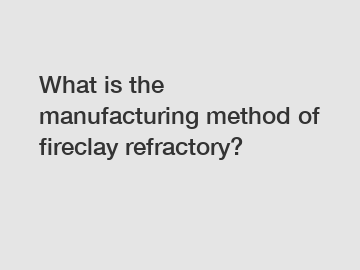Nov. 28, 2023
Minerals
What is the manufacturing method of fireclay refractory?
When it comes to fireclay refractory, a key question that arises is, "What is the manufacturing method of fireclay refractory?" In this article, we will delve into the various aspects of this manufacturing process, shedding light on the techniques involved, and exploring the reasons why fireclay refractory is widely used in various industries.
Fireclay refractories are a type of ceramic material that boasts excellent heat resistance and thermal shock properties. This makes them a popular choice for applications involving high temperatures, such as in the steel, glass, and cement industries. The manufacturing method of fireclay refractory involves several crucial steps, which we will outline below:

1. Raw Material Selection: The first step in manufacturing fireclay refractory involves careful selection of raw materials. Fireclay, which is a type of clay containing high levels of aluminum and silica, serves as the primary ingredient. Other additives may also be included to improve certain properties or enhance the material's performance.
2. Mixing and Blending: Once the raw materials are selected, they are mixed and blended together in precise proportions. This step ensures the desired composition and homogeneity of the refractory material. Often, water is added to create a workable paste-like consistency, making it easier to shape and mold.
3. Shaping: After the mixing and blending process, the fireclay refractory material is shaped into the desired forms. This can be done through various techniques, such as pressing, casting, or extrusion. Pressing involves compacting the material under high pressure, while casting involves pouring the mixture into molds. Extrusion, on the other hand, uses a machine to push the material through a die to create specific shapes.
4. Drying: Once shaped, the fireclay refractory material undergoes a drying process. This step is essential to remove moisture from the material and further enhance its strength. Drying can be done through natural methods, such as air drying, or through controlled heating in a specialized drying chamber.
Further reading:5. Firing: The final and most crucial step in the manufacturing method of fireclay refractory is firing. The shaped and dried refractory material is heated to extremely high temperatures in kilns or furnaces. During this process, the material undergoes physical and chemical changes, including sintering and vitrification. Sintering helps in bond formation and increased material density, while vitrification results in improved resistance to heat and chemicals.
Now, let's explore the reasons behind the widespread use of fireclay refractory in various industries:
1. High Temperature Resistance: Fireclay refractory exhibits excellent resistance to high temperatures, making it suitable for use in furnaces, kilns, and other heat-intensive applications. Its ability to withstand extreme heat without significant deformation or damage ensures long-lasting and efficient performance.
2. Thermal Shock Resistance: In addition to high temperature resistance, fireclay refractory also possesses exceptional thermal shock resistance. This property allows the material to withstand rapid temperature changes without cracking or spalling, ensuring its reliability in challenging environments.
3. Chemical Resistance: Many industries, such as the glass and cement industries, involve the use of corrosive materials. Fireclay refractory's chemical resistance makes it an ideal choice for applications where contact with acids, alkalis, or other aggressive substances is expected.
4. Versatility: Fireclay refractory can be manufactured in various shapes and sizes, adapting to the specific needs of different industries. Whether it's bricks, tiles, or special shapes, fireclay refractory can be easily customized to suit specific applications, improving efficiency and ensuring optimal performance.
In conclusion, the manufacturing method of fireclay refractory involves several crucial steps, from raw material selection to shaping, drying, and firing. Its excellent heat resistance, thermal shock properties, and chemical resistance make it a versatile material widely used in industries requiring high-temperature applications. The careful selection of raw materials and the precise execution of each manufacturing step contribute to the exceptional quality and performance of fireclay refractory. So, next time you encounter fireclay refractory, you'll have a deeper understanding of how it is manufactured and why it is the go-to choice for countless industrial applications.
Contact us to discuss your requirements of cordierite mullite refractory plates, Fireclay Brick Recipe, cordierite mullite plate supplier. Our experienced sales team can help you identify the options that best suit your needs.
Further reading:Previous: What is the machining process for Aluminium?
Next: Unveiling the Power of Tungsten Carbide Round Bar: Ultimate Guide & FAQs
Related Articles
If you are interested in sending in a Guest Blogger Submission,welcome to write for us!
All Comments ( 0 )